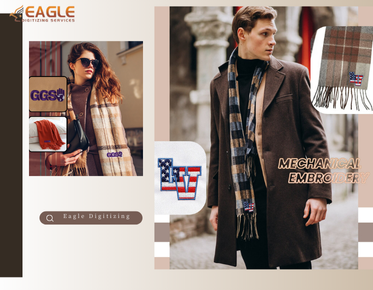File Formats for Embroidery Digitizing: What Works Best For Each Project?
In the intricate
world of embroidery, file formats are the unsung heroes. They dictate how your
designs will translate from digital files to beautifully stitched creations.
Choosing the right file format is not merely a technicality; it’s a pivotal
decision that can make or break your project. A suitable format ensures that
every stitch aligns perfectly, colors pop vibrantly, and details are rendered
accurately. Understanding the fundamentals of embroidery digitizing and the
nuances of file formats can elevate your craft and streamline your workflow.
Exploring Common File Formats Used in Embroidery
Overview
of Popular Formats: DST, PES, JEF, and More
Among the myriad
of file formats available, a few stand out as industry standards. DST (Data
Stitch Tajima) is perhaps the most recognized format, widely compatible with
various embroidery machines. PES (Personal Embroidery Software) caters to
Brother machines, while JEF (Janome Embroidery Format) is tailored for Janome
users. Each format serves its purpose, optimizing the design for specific
machine functionalities and capabilities. Understanding these distinctions is
crucial for any embroidery enthusiast or professional looking to achieve the
best results.
When
to Use Bitmap vs. Vector Graphics
When embarking on
the digitizing journey, one of the fundamental decisions revolves around bitmap
and vector graphics. Bitmap images, composed of pixels, are best for
photographs and complex images but can lose clarity when resized. In contrast,
vector graphics, created using mathematical equations, maintain their integrity
regardless of scaling. For embroidery, vectors often reign supreme because they
allow for cleaner lines and more precise shapes, essential for high-quality
stitching. Recognizing when to use each type can dramatically influence the
outcome of your projects.
Diving Deeper into Specific File Formats
DST:
The Standard for Embroidery Machines
DST is the gold
standard in the embroidery realm. Developed by Tajima, it is universally
compatible with a vast array of embroidery machines. This format excels at translating
designs into stitch files, making it a go-to for both hobbyists and
professionals. One of its notable advantages is its efficiency in handling
complex designs while maintaining a relatively small file size. However, it
does have its limitations, such as a lack of color information, which may
require additional steps for color management.
PES:
A Versatile Format for Brother Machines
PES files are the
workhorses of Brother embroidery machines. This format accommodates a wider
range of features compared to DST, including detailed color information and
support for multiple designs within a single file. PES is ideal for projects
that require intricate detailing and varied color palettes, making it a
favorite among embroiderers who value precision. Its versatility is unmatched,
allowing users to leverage Brother’s unique functionalities for a polished
finish.
JEF:
A Format Tailored for Janome Users
JEF files cater
specifically to Janome embroidery machines, offering compatibility and
optimized performance for Janome users. While it may not be as widely
recognized as DST or PES, JEF provides a robust option for those invested in
the Janome ecosystem. This format supports a rich array of design features,
including multiple colors and stitch types, allowing for creative freedom in
design while ensuring that projects translate smoothly to the machine.
Understanding Specialty File Formats
EXP:
A Format for Melco Machines
The EXP file
format is specifically designed for Melco embroidery machines, offering
features tailored to their unique capabilities. This format allows for advanced
stitch types and detailed design features, making it an excellent choice for
users of Melco systems. While less common than DST or PES, EXP files provide a
specialized option for those seeking to maximize their machine's potential.
CND:
Unique Features of the Bernina Format
CND files are
crafted for Bernina embroidery machines, showcasing unique features that
enhance the user experience. This format supports a variety of stitch types and
intricate design elements, making it ideal for users who prioritize detail. The
CND format is designed to fully leverage Bernina’s advanced functionalities,
ensuring that designs are executed flawlessly on the machine.
RTF:
When to Use the Tajima Format
RTF (Rich Text
Format) files are another specialty format, primarily used for Tajima machines.
This format is designed to handle complex designs while maintaining high
fidelity in stitch representation. RTF files are particularly advantageous for
projects that require rich detail and color accuracy, making them a preferred
choice for intricate embroidery applications.
Choosing the Right Format for Your Project Type
For
Text-Heavy Designs: Which Formats Work Best?
When it comes to
text-heavy designs, clarity is paramount. Formats like PES and JEF shine in
this area, as they support a wide range of fonts and allow for precise
stitching. These formats can handle the nuances of text, ensuring that letters
remain legible and well-defined. For straightforward, text-focused projects,
opting for one of these formats can streamline your workflow and enhance the
overall quality.
Complex
Graphics: The Best Formats for Detailed Artwork
For intricate
graphics that require fine detail, vector formats take the lead. SVG and AI
files are exceptional for capturing delicate elements and complex shapes,
making them ideal for sophisticated designs. When paired with the right
digitizing software, these formats can seamlessly translate detailed artwork
into stunning embroidery, preserving every nuance of the original design.
Simple
Logos: Lightweight Formats for Easy Stitching
For simple logos
and straightforward designs, lighter formats such as DST are ideal. Their
streamlined nature allows for quick processing and easy management, making them
perfect for less complex projects. Additionally, these formats are generally
compatible with a wide range of machines, ensuring that your logo looks sharp and
professional with minimal fuss.
Best Practices for File Conversion
How
to Safely Convert Between File Formats
Converting
between file formats can be a delicate process, but following best practices
ensures safety and quality. Always use reputable software that specializes in
embroidery digitizing to handle conversions. Additionally, keep a backup of
your original files to prevent any loss of data during the conversion process.
This precautionary step safeguards against unexpected issues that may arise.
Avoiding
Quality Loss During Conversion
Quality loss
during file conversion can be frustrating, particularly when working with
intricate designs. To avoid this pitfall, opt for conversion tools that
prioritize fidelity. Avoid compressing files unnecessarily and be cautious with
resizing, as these actions can degrade image quality. Taking the time to select
the right tools and methods will pay off in the long run.
Recommended
Tools for Converting Your Designs
Several tools are
available for converting embroidery file formats effectively. Software such asWilcom, Embird, and SewArt offers robust functionalities for file conversion
and digitizing. These programs allow for easy manipulation of designs while
ensuring that quality is maintained throughout the process. Familiarizing
yourself with these tools can greatly enhance your digitizing capabilities.
How to Optimize File Formats for Different Fabrics
Understanding
Fabric Types and Their Compatibility with Formats
Fabric choice
significantly impacts the compatibility of file formats. Different materials
behave uniquely during the embroidery process; thus, understanding their
characteristics is essential. For instance, heavier fabrics may require denser
stitch patterns, while lighter materials necessitate a more delicate approach.
Ensuring that your file format aligns with the fabric type can improve the
overall quality and appearance of the finished embroidery.
Adjusting
File Formats for Specialty Fabrics: Tulle, Velvet, and More
When working with
specialty fabrics like tulle or velvet, specific adjustments to your file
format may be necessary. Tulle, for example, is delicate and can easily become
distorted, requiring careful stitch placement and density adjustments. Velvet,
on the other hand, benefits from a design that minimizes friction and pulling.
Tailoring your file format to suit these unique characteristics will help
achieve stunning results.
Tips
for Ensuring Quality on Stretch and Knit Fabrics
Stretch and knit
fabrics present their own set of challenges. When digitizing these materials,
it's crucial to consider the inherent stretchiness and flexibility. Opt for
formats that allow for the use of lighter stitches and adjust densities to
prevent puckering. Additionally, incorporating underlay stitches can provide
stability, ensuring that the design adheres well to the fabric and maintains
its integrity.
Working with Multi-Color Designs
The
Importance of Color Profiles in Your File Formats
Color profiles
play a vital role in the success of multi-color designs. Properly managing
color information within your file format ensures that the final embroidery
mirrors your original vision. Formats like PES, which support multiple colors,
allow for intricate color management, making it easier to achieve the desired
aesthetic. Paying close attention to color profiles can elevate the quality of
your designs.
Managing
Thread Changes in Different File Formats
Managing thread
changes efficiently is crucial for multi-color projects. Formats such as JEF
and PES allow for easy thread color management, making it simple to track and
execute changes during the stitching process. Being meticulous about thread
management not only streamlines production but also enhances the overall
presentation of the finished piece.
Ensuring
Color Consistency Across Different Machines
Color consistency
is essential, particularly when using multiple embroidery machines. Different
machines may interpret color profiles variably, leading to discrepancies in the
final output. To mitigate this issue, stick to standardized color charts and
test your designs on each machine. This practice helps ensure that your colors
remain consistent, regardless of the equipment used.
Testing and Troubleshooting Your File Formats
Why
Test Stitching is Crucial Before Final Production
Test stitching is
a non-negotiable step in the embroidery process. It allows for real-world
assessment of your design, revealing potential issues that may not be apparent
in the software. You can identify problems like misaligned stitches, poor color
choices, or inadequate density before moving to final production by running a
test stitch.
Common
Issues to Look For in Each Format
Different file
formats may present unique challenges during the stitching process. For
example, DST files may struggle with complex color changes, while PES files
might exhibit thread tension issues. Awareness of these common pitfalls allows
for proactive troubleshooting, ensuring a smoother embroidery experience.
How
to Adjust Your Designs Based on Test Results
Once you’ve
completed your test stitching, analyze the results critically. Note any
discrepancies and adjust your design accordingly. This might involve tweaking
stitch density, altering color placements, or modifying stitch paths. Each
adjustment brings you closer to achieving the flawless finish you desire.
Navigating the world of embroidery digitizing and file formats can seem daunting, but experimentation is key. Every project offers different difficulties and chances for innovation. Embrace the process of discovering which formats work best for your designs, and don’t hesitate to try new approaches. With the right knowledge and tools, the impact of proper file formats can be profound, transforming your embroidery from ordinary to extraordinary. Happy stitching!



.png)